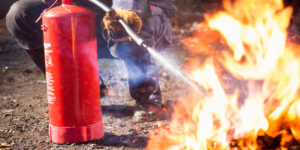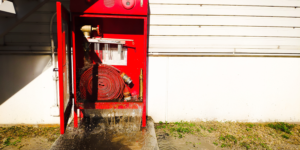Fire safety is essential in any facility, residential or commercial. We often overlook the protection our buildings give, but a fire reminds us how crucial safety precautions are. Installing fire sprinklers can make all the difference. Hidden heroes labor relentlessly to keep us safe and stop devastating fires. We’ll explain fire sprinklers, how they function, and why they’re essential to building safety.
The importance of fire safety in buildings
Fire prevention should always come first in building safety. Lives and property can be destroyed by sudden fires. This makes strong fire safety precautions essential. Fire safety in buildings goes beyond smoke alarms and extinguishers. These are crucial, but they may not be enough to fight a fire. Here come fire sprinklers.
Sprinklers are an active fire defense, responding immediately to flames. These devices direct water onto fires to control their growth and prevent spread. Fires can destroy lives and property, making fire safety crucial. Smoking or being trapped in a burning building can kill. Business owners may lose a lot if their buildings burn down.
Installing functional fire sprinkler systems gives buildings a strong first line of defense against fires. Early suppression can greatly lessen disaster damage.
Building owners show they care by installing sprinkler systems to protect residents and valuables. It also provides peace of mind by protecting against fire, one of the most devastating forces.

What are fire sprinklers and how do they work?
Sprinklers are crucial to structure fire safety. This fire-fighting equipment prevents fires from spreading and inflicting more harm. But how do fire sprinklers work? Fire sprinklers are pipes put throughout the building with sprinkler heads positioned at regular intervals. Fire-induced high temperatures activate heat-sensitive elements in each sprinkler head.
The nearest sprinkler head operates when fire heat raises the temperature significantly. This sprays water or other extinguishers into the flames below.
Not all sprinklers activate when one goes off, despite popular perception. Only the head nearest to the heat source activates, while others remain dormant until needed.
Activation occurs within seconds of reaching the predetermined temperature threshold for each system. When one active head releases water, it extinguishes nearby flames.
This focused approach efficiently suppresses fires before they spread. Fire sprinklers safeguard lives and property by putting out small fires quickly.
Stay tuned for our next blog post on “The benefits of installing fire sprinklers” to see why these systems are essential for building safety!
The benefits of installing fire sprinklers
Fire sprinklers can improve building safety and safeguard persons and property. Fire sprinklers quickly extinguish fires. They detect heat from a fire and activate water flow to extinguish flames. This fast response decreases the risk of major injury or death.
Installing fire sprinklers boosts property value and may lower insurance premiums due to reduced risk. Sprinkler systems increase safety and save property owners money, according to insurance providers.
Installing fire sprinklers shows safety and compliance. Residents feel safe because emergency measures have been taken.
Fire sprinkler regulations and codes
Building safety depends on fire sprinkler codes. These rules ensure fire sprinkler systems satisfy criteria. These rules cover system design, installation, and maintenance. Building code compliance is crucial to fire sprinkler requirements. Building codes mandate fire protection measures for safe structures. These codes generally demand fire sprinklers in high-rise and commercial structures.
Building occupancy type and size affect these laws. Planning fire sprinkler installation requires consulting these standards to assure compliance. Fire sprinkler laws cover system design and performance. Their criteria include water supply, pipe sizing, sprinkler spacing, and activation temperatures. Follow these suggestions to ensure the system controls or extinguishes fires quickly.
Inspections and testing are very important under these requirements. Fire departments generally require periodic inspections to ensure system functionality.
Compliance with fire sprinkler rules improves safety and can lower property insurance costs. Buildings with fire protection may receive lower premiums or other incentives from insurers.
Types of fire sprinkler systems
There are many fire sprinkler systems that can be customized for different structures. Wet pipe systems are the simplest and most common. Water pipes and sprinklers make up its system.
For cold weather, the dry pipe system is another option. Instead of water, these pipelines hold compressed air or nitrogen. When a sprinkler head opens, air pressure lowers, allowing water to flow through pipes and onto the fire.
Other options include pre-action systems for facilities with valuable assets or sensitive equipment. Before water is discharged, a smoke detector or heat sensor must indicate a fire threat, and a sprinkler head opening must open.
Deluge systems are employed in hazardous places like chemical storage and power stations. Open nozzles release massive amounts of water simultaneously when activated by detectors or manually.
Different fire sprinkler systems have pros and downsides based on building occupancy, dangers, and budget. Fire protection experts can assist you choose the right type for your building.
Cost and maintenance considerations
Fire sprinkler installation requires cost and maintenance considerations. The initial cost of installation may appear high, but a reliable fire suppression system can save money in the long run.
Building size and layout are important. Sprinkler systems in larger buildings cost more upfront and in maintenance. Unique architectural features or intricate layouts may necessitate customized installations, which might increase expenses.
Maintenance should also be considered. Fire sprinkler systems need frequent inspections, testing, and maintenance to work effectively. This includes checking for pipe leaks, water pressure, and component functionality.
While fire sprinkler maintenance expenditures are ongoing, they pale in comparison to catastrophic fire damages. If fire sprinklers aren’t properly installed or maintained, life-safety dangers outweigh the cost.

Common misconceptions about fire sprinklers
There are several misconceptions about fire sprinklers. Let’s dispel some of these fallacies to comprehend building fire sprinkler systems.
Fire sprinklers are often thought to be easily triggered by cooking smoke or heat. This is false. When temperatures reach 155-165 degrees Fahrenheit, fire sprinklers activate. They limit erroneous activations by reacting selectively to fire heat.
Another myth is that if one sprinkler head is triggered, they all go off. In actuality, only the sprinkler head nearest to the heat source will operate, containing or extinguishing the fire.
Some think fire sprinklers’ water harm during a small fire exceeds their benefits. Studies demonstrate that only one or two sprinkler heads need to activate in most fires, causing less water damage than hoses.
There’s also a misunderstanding about fire sprinkler maintenance and reliability. Some think these systems need constant maintenance and may break down when needed. Modern fire sprinkler systems are reliable and low maintenance if built by specialists.
Some believe smoke detectors alone protect against fires. Smoke alarms inform inhabitants of potential threats and allow for escape time, but automatic sprinkler systems dampen fires and limit property damage and save lives.
These fire sprinkler myths must be dispelled to fully comprehend their usefulness in saving buildings from deadly fires.
Steps to take for installation of fire sprinklers in a building
Installing fire sprinklers in a building requires multiple processes. These processes enable optimal fire prevention system design and installation.
First, inspect the building’s layout and fire dangers. This includes placing sprinkler heads based on ceiling height, impediments, and ventilation systems.
Next, get a fire protection engineer or contractor to design the sprinkler system for the structure. They will generate local code-compliant plans and specifications.
After design, local permits must be obtained before installation. This follows rules and regulations.
Professional installers will precisely set each sprinkler head according to design requirements. Installing pipes between the heads will ensure system water flow.
To ensure all components work, extensive testing must follow installation. Hydrostatic pipe system tests and sprinkler head functioning tests are included.
Fire sprinkler systems need ongoing maintenance to work properly. Trained personnel should inspect often to spot problems and fix them quickly.
Installing fire sprinklers in a structure using these techniques can greatly improve fire safety. Do not underestimate how this simple yet efficient strategy can save lives and property in an emergency!
